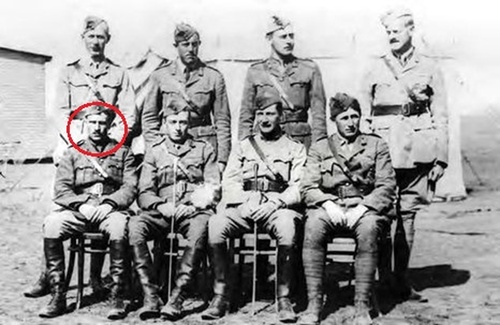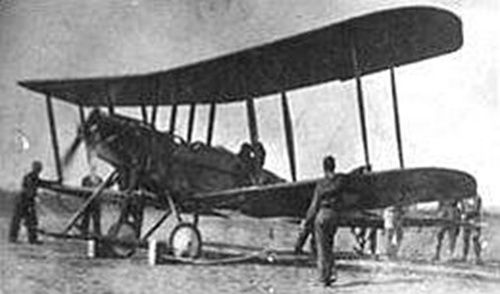Auction: 24003 - Orders, Decorations and Medals
Lot: 121
(x) The Great War campaign group of three awarded to Captain G. S. Creed, South African Aviation Corps and Royal Air Force, one of a band of early African Aviators who took Aviator's Certificate No. 822 in June 1914
1914-15 Star (Capt. G. S. Creed. S.A. Aviatn. C.); British War and Victory Medals (Capt. G. S. Creed. R.A.F.), very fine (3)
The South African Aviation Corps comprised just 17 officers and 121 other ranks, and served in German South West Africa from March to July 1915.
Gordon Shergold Creed was born on 5 March 1890 at Grahamstown, South Africa.
On 10 September 1913 General J. C. Smuts representing the Government of the Union of South Africa, and Cecil Compton Paterson in his personal capacity signed a Memorandum of Agreement whereby the Government agreed to have 10 candidate Pilots trained at Alexandersfontein on the outskirts of Kimberley. The trainees included Ken van der Spuy, B.H. Turner, G.S. Creed, G. Clisdal, E.C. Emmett, G.P. Wallace, M.S. Williams, Hopkins, Solomon and M. van Coller. Private pupils included Arthur Turner (not to be confused with B.T. Turner) who was Paterson's mechanic, and Miss A.M. Bociarelli. Creed was one of the very first pilots of the South African Aviation Corps.
Lionel Friedberg in his book, The Flying Springbok: A History of South African Airways Since Its Inception, takes up the story:
'Six of the original group of pilots were chosen to undergo further training in Britain and were appointed as probationary lieutenants of the South African Defence Force. They were Kenneth van der Spuy, Gordon Creed, Marthinus Williams, Basil Turner, Gerard Wallace and Edwin Emmet. All took part in preliminary courses at Tempe, Bloemfontein, before being sent for training at Upavon. When van der Spuy passed his final examination on 2 June 1914 and was granted the certificate of the Royal Aero Club, he was South Africa's first qualified military pilot. Creed was issued with his aviator's certificate at Upavon on 24 June 1914.
In January 1914, Defence Headquarters purchased the Paterson Aviation Syndicate School, the aircraft and all spares, but the biplane was never put to any use and was found years afterwards in a Cape Town Drill Hall in a dilapidated condition. Its later fate is unknown. Early in 1915, van der Spuy, Creed, Turner and Wallace were asked to establish a South African Aviation Corps (SAAC) in England and make preparations to go to South-West Africa to assist the South African land forces under General Louis Botha in their fight against the German Schutztruppe.
It was a monumental undertaking for the young officers, and they had to persuade, beg and collect not only the aircraft required for such a venture, but spares, equipment and supplies of any kind as well. For this they had to deal with the War Office, the Royal Flying Corps and the Royal Navy, all august bodies with their own rules of doing business, and not in the least inclined to assist.
Eventually they managed to prise six all-steel Farmans from the Flying Corps, with the suitable 150 hp French Canton-Unne engines generously supplied by the Admiralty. In addition, two BE 2C airplanes were shipped off, and three flying officers - Lieutenants Cripps, Wood and Henshilwood, seconded from the Royal Flying Corps. However, the BE 2Cs were underpowered, their wooden frames warped during the sea voyage and dried out in the African heat, and they were therefore useless. By the end of May 1915, all aircraft and equipment had arrived in Walvis Bay. As a consequence of a wet voyage, when the Farmans had been lashed in crates on deck, two aircraft had to be reconstructed and the others thoroughly cleaned. When the first plane was ready, van der Spuy made the first reconnaissance flight on 6 May 1915 over the area around Walvis Bay.
From Walvis Bay, the aircraft were flown to Karibib where they could make use of the existing German airstrip and hangars. This place became the first base of the SAAC, although they operated later from other airfields as well. By this time the German aircraft had ceased operations, and no aerial battles took place. The tables were turned, and the SAAC had a clear run during their reconnaissance missions. Occasionally they dropped 20- and 120-pound shells on the enemy, and a lucky hit destroyed a locomotive at Tsumeb.
After having flown over South-West for just about two months, the unit was sent back to England to become No 26 (South African) Squadron of the Royal Flying Corps (RFC). Their emblem was a Springbok with crown and wreath and the motto: 'n Wagter in die Lug.' Creed was initially attached to Number 5 Squadron, Royal Flying Corps.
'At Thetford, on November 30, 1917, in a "rumpty" (Maurice Farman S.11), Barksdale had his first experience of flying: "Oh but it was a lovely ride tho the air was rather bumpy & we would sometimes drop about 40 feet in a pocket. And in fact it was so bumpy that Capt. Creed (my instructor) would not let me use the joy stick any." A week later, he watched as the plane, piloted by Gordon Shergold Creed, with his friend Roberts as passenger, crashed and caught fire; Roberts's injuries were minor, but Creed was hospitalized, and the "machine was a 'write off'." This was one of many crashes Barksdale witnessed and recorded'.
(Extracted from the war services of Eugen Hoy Barksdale, https://parr-hooper.cmsmcq.com/2OD/the-biographies/eugene-hoy-barksdale/)
After the war he returned to South Africa taking advantage of the Soldier Settlement Scheme where he died on 17 November 1966 at Komga, Cape Province, S. Africa.
There are, as expected, numerous references to Creed in books about the pioneering days of the South African Aviation Corps and online references.
Subject to 5% tax on Hammer Price in addition to 20% VAT on Buyer’s Premium.
Sold for
£650
Starting price
£400
Sale 24003 Notices
Creed also earned a 'mention' as per London Gazette 30 June 1916 as a Temporary Captain, Royal Flying Corps.









